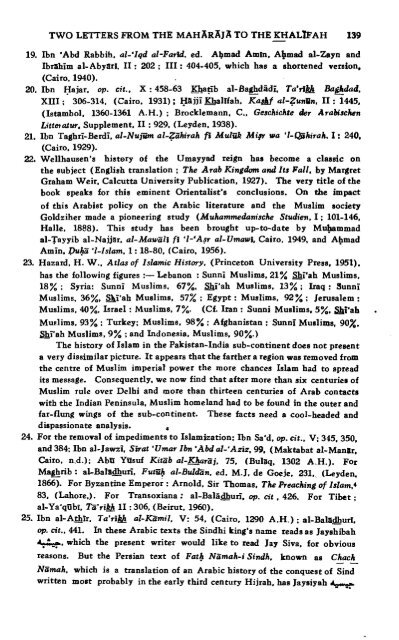TWO LETTERS FROM THE MAHARAJA TO THE KHALIFAH
TWO LETTERS FROM THE MAHARAJA TO THE KHALIFAH
TWO LETTERS FROM THE MAHARAJA TO THE KHALIFAH
You also want an ePaper? Increase the reach of your titles
YUMPU automatically turns print PDFs into web optimized ePapers that Google loves.
<strong>TWO</strong> <strong>LETTERS</strong> <strong>FROM</strong> <strong>THE</strong> <strong>MAHARAJA</strong> <strong>TO</strong> <strong>THE</strong> - KHALEAH 139<br />
19. Ibn 'Abd Rabbih. al-'Iqd al-Fartd. ed. Ahmad Amin, Abmad al-Zayn and<br />
Ibrahim al- Abyari. I1 : 202 ; I11 : 404-405. which has a shortened version,<br />
(Cairo. 1940).<br />
20. Ibn Hajar. op. cit.. X : 458-63 aa@b al-Ba&didi. Ta'rfa &&dad.<br />
XI11 : 306-314. (Cairo. 1931) ; Hajji bllfah. Ka&f al-Zuniln. I1 : 1445,<br />
(Istambol. 1360-1361 A.H.) ; Brocklemann. C.. Geschichte der Arabisckn<br />
Litteatur. Supplement. I1 : 929. (Leyden. 1938).<br />
21. Ibn Taghri-Berdi. al-Nuj-m al-Z~hirah fi Mullk Mip wa 'I-QZhirah. I: 240.<br />
(Cairo. 1929).<br />
22. Wellhausen's history of the Umayyad reign has become a classic on<br />
the subject (English translation : The Arab Kingdom and Its Fall. by Margret<br />
Graham Weir. Calcutta University Publication. 1927). The very title of the<br />
book speaks for this eminent Onentalist's conclusions. On the impact<br />
of this Arabist policy on the Arabic literature and the Muslim society<br />
Goldziher made a pioneering study (Muhammedanische Studien. 1 : 101-146,<br />
Halle. 1888). This study has been brought up-to-date by Mubmmad<br />
al-Tayyib al-Najjar. al-Mawali fi 'I-'A2r al-Umawi, Cairo. 1949, and Ahmad<br />
Amin. Du&i 'I-Islam. 1 : 18-80, (Cairo. 1956).<br />
23. Hazard. H. W.. Atlas of Islamic History. (Princeton University Press. 1951).<br />
has the following figures :- Lebanon : Sunni Muslims. 21% ai'ah Muslims.<br />
18% ; Syria: Sunni Muslims. 67%. ai'ah Muslims. 13%; Iraq : Sunni<br />
Muslims. 36%. ayah Muslims. 57% : Egypt : Muslims. 92% : Jerusalem :<br />
Muslims. 40%, Israel : Muslims, 7%. (Cf. Iran : Sunni Muslims, 5%. &i'ah .<br />
Mudims. 93% : Turkey; Muslims. 98% : Afghanistan : Sunni Muslims, 90%.<br />
&'ah Muslims. 9% ; and Indonesia. Muslims. go%.)<br />
The history of Islam in the Pakistan-India sub-continent does not present<br />
a very dissimilar picture. It appears that the farther a region was removed from<br />
the centre of Muslim imperial power the more chances Islam had to spread<br />
its message. Consequently, we now find that after more than six centuriee of<br />
Muslim rule over Delhi and more than thirteen centuries of Arab contacts<br />
with the Indian Peninsula. Muslim homeland had to be found in the outer and<br />
far-flung wings of the sub-continent. These facts need a cool-headed and<br />
dispassionate analysis. I<br />
24. For the removal of impediments to Islamization: Ibn Sa'd. op. cit.. V; 345, 350,<br />
and 384; Ibn al-Jawzi. Sirat 'Umar Ibn 'Abd al-'Aziz. 99. (Maktabat al-Manure<br />
Cairo. n.d.1; Abti YBsuf Kitab al-=r~j. 75, (Bul~q. 1302 A.H.). For<br />
Maghrib - : al-Bal@ud. Futiib al-Buldiin. ed. M.J. de Goeje. 231. (Leyden,<br />
1866). For Byzantine Emperor : Arnold, Sir Thomas, The Preaching of Islarn.4<br />
83, (Lahore.). For Transoxiana : al-BalHaur?, op. cit . 426. For Tibet ;<br />
al-Ya'qnbi. T5'riM 11 : 306. (Beirut, 1960).<br />
25. Ibn al-Aair. Ta'rifi aLKEmil. V: 54. (Cairo. 1290 A.H.) ; al-Bala&uri.<br />
op. cit., 441. In these Arabic texts the Sindhi king's name reads as Jayshibah<br />
++ which the present writer would like to read Jay Siva, for obvious<br />
reasons. But the Persian text of Fatb Niimah-i Sindh, known as Chach<br />
- -<br />
Niimah, which is a translation of an Arabic history of the conquest of Sind<br />
written most probably in the early third century Hijrah, has Jaysiyah &
















